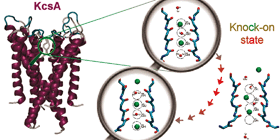Insight into the origins of the barrier-less knock-on conduction in the KcsA channel: molecular dynamics simulations and ab initio calculations†
Abstract
Since the pioneering work of Zhou et al. (Y. Zhou, J. H. Morais-Cabral, A. Kaufman and R. MacKinnon, Nature, 2001, 414, 43–48) it is now well established that the streptomyces lividans potassium channel (KcsA) can accommodate more than one ion, namely between 2 and 3. As a result, it is usually assumed that the conduction of ions proceeds through a barrier-less knock-on mechanism. This one is an alternation of two sequences containing either 2 or 3 ions which have nearly the same energies. However, the origin of such knock-on mechanism is not clearly known. The entry and the exit of ion in or out of the selectivity filter are suspected to be due to the repulsive interactions between ions. In this work, molecular dynamics simulations running over nanoseconds have been done in order to identify such events. Two specific situations, namely (S1, S3) containing 2 ions and (S2, S4) containing 3 ions, have been investigated regarding the different locations that ions can occupy during their diffusion through the selectivity filter of KcsA. We show that contractions of the (S1, S3) file and dilation of the (S2, S4) file are at the origin of the passage from one sequence to the other. The comparison between the experimentally observed diffusion rate and the occurrence’s frequency of such contractions or dilation confirm the importance of such events. Ab initio calculations have also been conducted in order to examine the effect of ion polarization in the filter of KcsA. During the contraction of the ion/water file, one charge at the extra-cellular mouth of the channel strongly deviates from the others. This behavior could guide the diffusion direction to a certain extent since the contraction of the (S1, S3) is favored.


 Please wait while we load your content...
Please wait while we load your content...